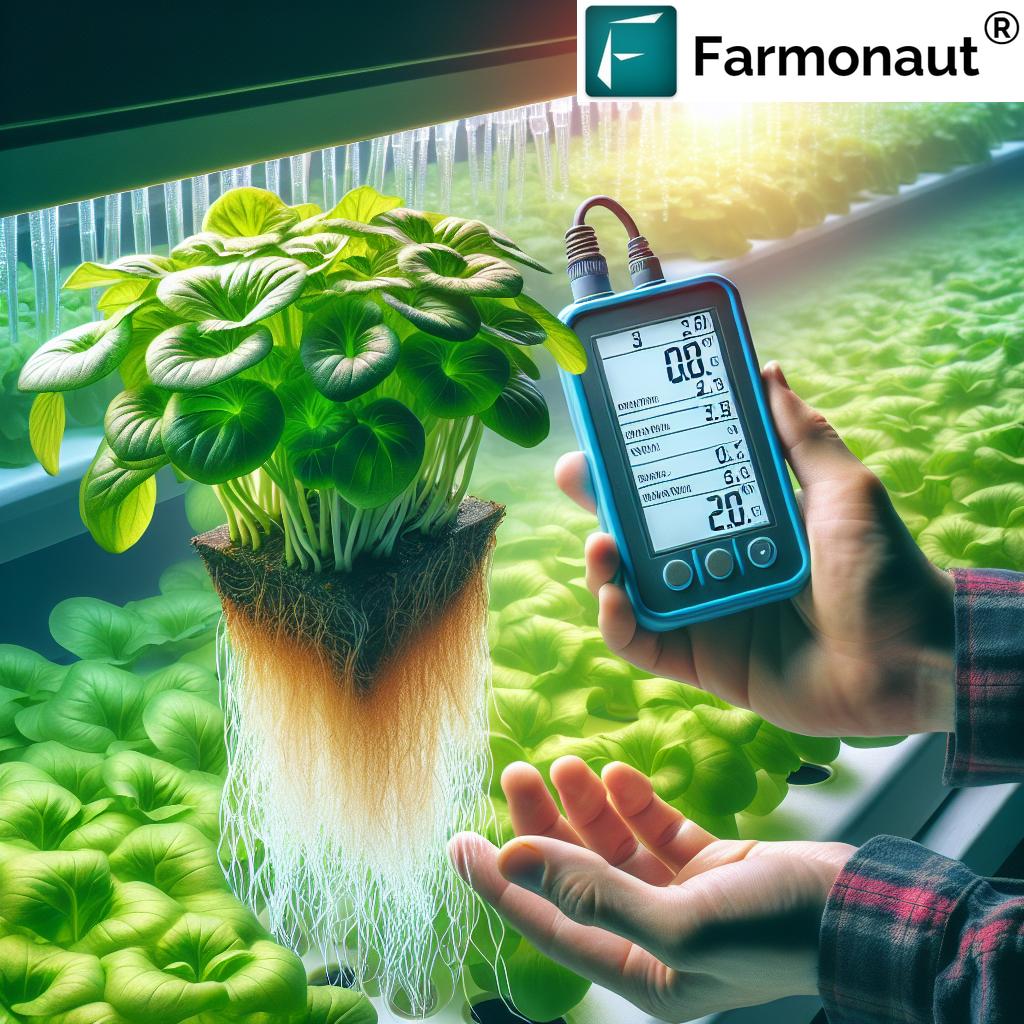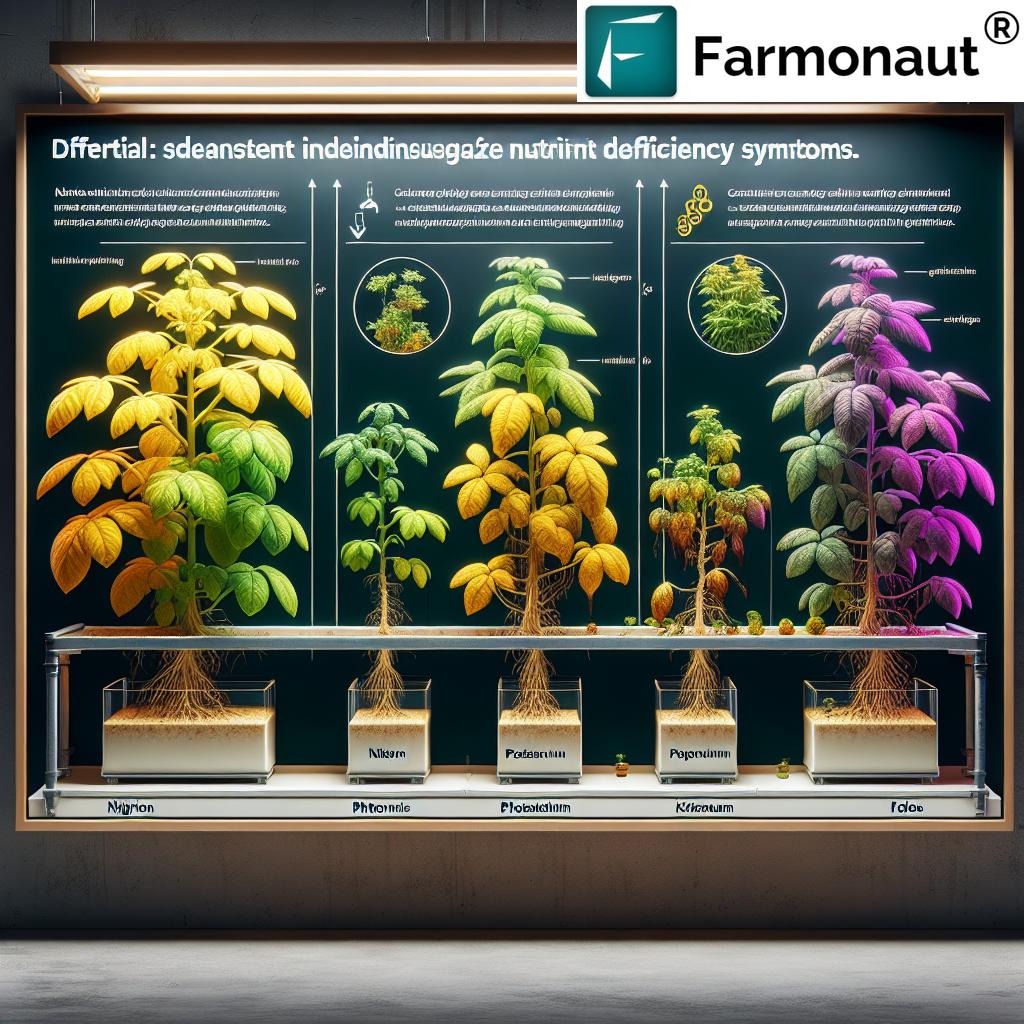Hydroponic Nutrients: 7 Shocking Growth Boosters!
Summary: Hydroponics, the method of growing plants without soil, relies on hydroponic nutrient solutions to deliver essential nutrients for plant growth directly to the roots. This innovative practice offers precise control over nutrient availability, resulting in optimized plant growth, healthy development, and increased yields. Understanding macronutrients and micronutrients in hydroponics is crucial for successful, sustainable cultivation. Let’s explore the science—and the shocking facts—behind these growth boosters, including spotting nutrient deficiency symptoms in plants, mastering advanced hydroponic nutrient management, and leveraging cutting-edge Farmonaut technology.
“Hydroponic plants can grow up to 50% faster with optimized nutrient solutions compared to traditional soil methods.”
Table of Contents
- What are Hydroponic Nutrients?
- Essential Nutrients for Hydroponic Plant Growth
- Hydroponic Nutrients: 7 Shocking Growth Boosters
- Formulating Hydroponic Nutrient Solutions
- Monitoring pH and EC in Hydroponics
- Nutrient Deficiency Symptoms in Plants & Correction
- Hydroponic Nutrient Comparison Table
- Recycling Nutrient Solutions & Sustainable Practices
- Farmonaut Technology in Advanced Hydroponic Nutrient Management
- Conclusion: Maximizing Results with Advanced Hydroponics
- FAQs About Hydroponic Nutrients
What are Hydroponic Nutrients?
In hydroponics, we bypass soil to grow plants, instead supplying nutrient-rich water solutions directly to root systems. These hydroponic nutrient solutions deliver essential nutrients for plant growth with precise control. Unlike in traditional cultivation, where soil microbes and composition impact nutrient availability, hydroponics offers us real-time management of which nutrients plants absorb—and in what quantities. The result? Optimized growth, healthier plants, faster development, and increased yields.
This method involves monitoring and precise adjustment of critical parameters. The macronutrients and micronutrients in hydroponics are provided in well-balanced ratios—tailored to crop type and growth stage.
Farmonaut’s advanced satellite-based monitoring and AI-powered analytics further empower growers with actionable data on nutrient deficiencies, crop health, water management, and environmental impacts, ensuring modern, innovative, and sustainable hydroponic practices.
Essential Nutrients for Hydroponic Plant Growth
Plants require a diverse range of essential elements for optimal growth, development, and successful hydroponics cultivation. These are divided into two groups:
- Macronutrients: Needed in greater amounts; form the cornerstone of plant health, structure, and function.
- Micronutrients: Required in trace amounts but vital for enzyme activation, cellular processes, and overall vigor.
Correctly balancing these nutrients ensures robust growth, prevents stunted development, and mitigates common deficiency symptoms such as yellowing leaves, weak stems, or malformed structures.
Why focus on nutrients in hydroponics?
- Direct delivery eliminates soil-related nutrient loss
- Immediate symptom visibility: We can quickly spot and correct issues like nitrogen, potassium, and other deficiencies simply by observing the leaves (yellowing, purplish tinge, brittle edges, etc.)
- Fine-tuned management: Ongoing monitoring of pH and EC ensures optimal concentrations for plants at every growth stage.
Macronutrients and Micronutrients in Hydroponics — The Building Blocks
Let’s examine these nutrients and their impact:
- Nitrogen (N): Paramount for leaf and stem growth. Integral in formation of amino acids and chlorophyll. Deficiency leads to stunted growth and yellowing leaves.
- Phosphorus (P): Vital for energy transfer, healthy root systems, and flowering. Deficiency manifests as poor root growth, purplish leaves.
- Potassium (K): Regulates water uptake, enzyme activation, and disease resistance. Deficiency causes weak stems, yellowing edges, and necrosis.
- Calcium (Ca): Creates structural cell wall stability. Lack of calcium results in blossom-end rot, cellular collapse, and tip-burn.
- Magnesium (Mg): Central to chlorophyll production and enzyme function. Deficiency causes yellowing between leaf veins.
- Sulfur (S): Supports protein synthesis and plant vigor. Deficiency leads to yellowing of new, younger leaves.
Micronutrients—Iron, Manganese, Zinc, Copper, Molybdenum, Boron—are just as important! Their absence disrupts enzyme function, photosynthesis, and hormone regulation, leading to specific symptoms in plant leaves, roots, and structure.
“Over 90% of hydroponic growers report visible deficiency symptoms when nutrient balance is not properly managed.”
Hydroponic Nutrients: 7 Shocking Growth Boosters
Through years of research and innovation, we’ve identified seven stand-out nutrients and nutrient-based techniques that profoundly boost hydroponic plant growth. Each is central to achieving optimal nutrient concentrations for plants, robust root and leaf formation, and maximizing yields. Let’s break down these 7 shocking boosters:
-
1. Nitrogen (N)
- Function: Forms the foundation for leaf growth, stem elongation, chlorophyll production, and overall vegetative vigor.
- Deficiency: Stunted growth, striking yellowing of older leaves.
- Innovation: Fast-acting nitrate formulations ensure immediate uptake in closed hydroponic systems; automated dosing technologies maintain steady supply. Farmonaut’s NDVI crop health monitoring can flag nitrogen-related chlorophyll loss and alert growers early.
-
2. Phosphorus (P)
- Function: Fuels cellular energy (ATP), strong roots, and abundant flowering/fruiting.
- Deficiency: Poor root growth, slow maturation, purple hue on underside of leaves.
- Innovation: Hydrolyzed phosphate solutions remain available despite fluctuating pH, supporting root formation and energy transfer through targeted application.
-
3. Potassium (K)
- Function: Critical for water uptake, activating over 60 plant enzymes, ensuring resistance to diseases, and maintaining cell hydration.
- Deficiency: Leaf edges turning yellow/brown (“scorch”), droopy/wilting growth, and poor fruit quality.
- Innovation: Advanced potassium sources are chelated for maximal absorption. Sensor-based dosing can stabilize concentrations and reduce waste.
-
4. Calcium (Ca)
- Function: Key to cell wall structure, promoting cell stability, healthy root tips, and blossom-end development.
- Deficiency: Tip burn, blossom-end rot, and in severe cases, plant death. Most severe in tomato/pepper hydroponics.
- Innovation: Rapid-soluble calcium chelates deliver this element without interfering with other ions (reducing lockout risk), supporting shelf life and transport resilience of produce.
-
5. Magnesium (Mg)
- Function: Central atom in chlorophyll; powers photosynthesis and numerous plant-enzyme activities.
- Deficiency: Interveinal yellowing of leaves; reduced productivity and leaf curl.
- Innovation: “Dual-component” magnesium blends are stable, even at changing pH/EC, and can be tailored to different hydroponic crops.
-
6. Iron (Fe)
- Function: Directly involved in chlorophyll synthesis and electron transport (photosynthesis and cellular respiration).
- Deficiency: Leaves show sharp yellowing, veins remain green (“iron chlorosis”).
- Innovation: Nanoparticle-chelated iron ensures steady supply, especially under alkaline conditions where iron otherwise becomes unavailable.
-
7. Boron (B)
- Function: Vital for cell division, pollen formation, and sugar transport in plants. Supports proper flower/fruit development.
- Deficiency: Young leaves turn brittle, malformed; poor pollination, low fruit set.
- Innovation: Precise boron levels calculated with AI tools can prevent over- or under-dosing, minimizing risk of toxicity and supporting large-scale hydroponic farm management.
Formulating Hydroponic Nutrient Solutions
Formulating hydroponic fertilizers involves mixing precise combinations of essential salts and micronutrients for maximum plant uptake. A classic framework, such as the Hoagland solution, provides a scientific baseline: it contains all necessary elements in research-backed ratios.
- Adjustment: Each plant species—and even each stage of growth—may require different nutrient ratios. For example, leafy greens thrive with higher nitrogen, while flowering crops need more phosphorus and potassium.
- Effective Management: Recirculating systems require frequent solution replenishment, while single-pass (drain-to-waste) systems may need regular disposal and fresh formulation.
- Precision Monitoring: Tools like EC and pH meters are essential for keeping nutrients in optimal concentrations for plants, while Farmonaut’s AI-based alerts take adaptation to a new level (see below).
Monitoring pH and EC in Hydroponics
Monitoring pH and EC in hydroponics is the linchpin of successful nutrient management:
- pH: Dictates the availability of nutrients. The optimal range—between 5.5 and 6.5—promotes maximum absorption. A shift out of this range may cause “nutrient lockout,” leading to apparent deficiency symptoms even when nutrients are present!
- EC (Electrical Conductivity): Reflects the overall strength of the nutrient solution. Higher EC means greater nutrient concentration, but excessive EC can burn roots or inhibit water uptake. Frequent EC monitoring allows us to prevent over-fertilization or deficiencies.
- Farmonaut’s Technology: AI-triggered signals—powered by satellite imagery and field sensors (as part of Farmonaut’s advisory system)—guide growers on water/nutrient imbalances, preventive management, and crop stability.
How often should we check? Commercial growers check pH and EC daily, while hobbyists may check every 2–3 days.
Nutrient Deficiency Symptoms in Plants & Correction
Rapidly diagnosing nutrient deficiency symptoms in plants is a core skill for hydroponic growers. Because hydroponic systems operate without a “nutrient buffer” like soil, any slight miscalculation or system fault can immediately impact plant health.
Most Common Deficiency Symptoms
- Nitrogen: Older leaves yellow from the tip (chlorosis), stunting overall growth.
- Phosphorus: Leaves (especially lower ones) may appear purplish; sluggish root development.
- Potassium: Yellow or necrotic leaf edges, leaf curling, and increased susceptibility to disease.
- Calcium: Tip burn on lettuce, blossom-end rot in tomatoes; distorted, dying growing tips.
- Magnesium: Interveinal yellowing (veins remain green) in lower leaves; reduced chlorophyll synthesis.
- Sulfur: Yellowing of new/younger leaves; stunted development.
- Iron: New leaves yellow, but leaf veins stay green.
- Manganese, Zinc, Boron, Copper, Molybdenum: Each causes unique leaf, root, or stem symptoms, such as malformations, stunting, or wilting.
Correction Strategies:
- Immediate Solution Adjustment: Use diagnostic guides and digital tools to adjust concentrations to optimal levels for affected plants.
- Flush and Replace Solution: In severe deficiency or excess, flush the system with clean water before reintroducing a balanced nutrient solution.
- Root Zone Monitoring: Check root color and structure (roots should be white/cream, not brown or slimy).
- Leverage Technology: Tools such as Farmonaut’s traceability platform aid in tracking fertilization practices and optimizing input management, providing transparency and instant feedback loops.
Hydroponic Nutrient Comparison Table
This hydroponic nutrient comparison table allows readers to quickly assess each nutrient’s function, symptoms, dosing, and environmental footprint. Perfect for identifying problems and supporting sustainable hydroponic practices:
| Nutrient Name | Function / Role in Growth | Deficiency Symptoms | Recommended Conc. (ppm) | Tech/Innovation Involved | Environmental Impact |
|---|---|---|---|---|---|
| Nitrogen (N) | Leaf/stem growth, chlorophyll, amino acids | Stunted growth, yellowing leaves (oldest first) | 140–250 | Nitrate-based dosing; AI crop health monitoring | Quick uptake reduces runoff; low waste in recirculating systems |
| Phosphorus (P) | Energy transfer, root/flowering, DNA synthesis | Poor roots, purplish leaves, slow growth | 30–80 | pH-stable solutions, sensor-controlled application | Minimized leaching via closed systems |
| Potassium (K) | Enzyme activation, water uptake, disease resistance | Yellow leaf edges, weak stems, wilting | 150–350 | Chelated forms; sensor-assisted dosing | Efficient use reduces environmental loading |
| Calcium (Ca) | Cell wall structure, tip/stem stability | Blossom end rot, stunted/dead tips | 80–200 | Rapid-soluble chelates prevent precipitate | Enables healthy produce, less postharvest waste |
| Magnesium (Mg) | Chlorophyll/core of photosynthesis, enzymes | Yellowing between leaf veins, leaf curl | 30–70 | Dual-component blends; stable at variable pH | Recirculated, low-risk for groundwater |
| Iron (Fe) | Chlorophyll formation, enzyme function | Yellow leaves, green veins (chlorosis) | 2–4 | Nanoparticle-chelated iron | Low dosage, little environmental risk |
| Boron (B) | Cell division, pollen, sugar transport | Brittle/malformed leaves, poor flowering | 0.3–1 | AI-guided dosing/calibration | Minimized toxicity via precision application |
Recycling Nutrient Solutions & Sustainable Hydroponic Practices
Sustainability is at the core of modern hydroponic nutrient management. Because hydroponics involves recirculating water and nutrients, we dramatically reduce waste—compared to field-based agriculture, where leaching and runoff are rampant.
- Recycling Nutrient Solutions: Recirculating systems (NFT, DWC, etc.) reuse water and nutrients. Regular monitoring of EC and pH ensures nutrient concentrations remain optimal.
- Eco-Friendly Fertilizers: Use of mineral-based, organic, or even recycled nutrient sources is possible. Choosing environmentally responsible solutions reduces the footprint of controlled-environment farming.
- Resource Monitoring: Farmonaut’s carbon footprinting tools empower growers to minimize environmental impact—by tracking and optimizing input use, emissions, and resource allocation.
- Minimizing Toxicity Risks: Automated, AI-driven dosing technologies track for excesses that could threaten plant health or contribute to environmental problems.
Farmonaut Technology in Advanced Hydroponic Nutrient Management
Advanced hydroponic technologies are revolutionizing how we practice precision agriculture—especially regarding nutrient monitoring, deficiency detection, and sustainable results. Farmonaut is at the forefront with tools that include:
- Satellite-Based Crop Monitoring: Multispectral imaging reveals even subtle nutrient deficiencies—across large operations or small urban farms alike.
- AI-Based Advisory: Jeevn AI provides farmers real-time, personalized advice for irrigation, nutrient timing, and system troubleshooting—maximizing plant health and yield.
- Product Traceability with Blockchain: Secures supply chains, records input application, and improves both transparency and safety (learn more about Farmonaut Traceability).
- Resource Optimization: Fleet and water management features support large-scale farm operators in minimizing waste and improving fleet management efficiency.
- Carbon Footprinting: Automated, field-level tracking of emissions and resource use enables sustainable hydroponic practices (learn how to monitor your environmental impact).
With these tools—available across web, Android, iOS, and via API integrations—we empower growers to implement truly advanced, data-driven hydroponic nutrient management at any scale.
- Real-time crop health and nutrient deficiency detection
- Actionable, AI-based advisory for hydroponic nutrient dosing & deficiency correction
- Resource tracking, carbon accounting, and blockchain-based product traceability solutions
Conclusion: Maximizing Results with Advanced Hydroponics
Effective hydroponic nutrient management is fundamental to plant health, growth, and productivity. By understanding essential hydroponic nutrients, formulating tailored solutions, diligently monitoring key parameters like pH and EC, and adopting truly sustainable practices, we empower ourselves to achieve thriving, resilient crops in any environment.
Today’s growers aren’t just farmers—they’re data-driven innovators, harnessing technology from Farmonaut to sharpen decision-making and drive outstanding results. With precision monitoring and AI-based insights, it’s never been easier to prevent nutrient deficiencies, maximize system efficiency, and promote environmental stewardship.
Ready to move beyond guesswork? Embrace the future of hydroponics with real-time monitoring, effective nutrient management, and advanced sustainability tools—for hobby gardens or commercial-scale operations alike.
FAQs About Hydroponic Nutrients
- Q1: What are hydroponic nutrients and why are they essential?
- Hydroponic nutrients are water-soluble compounds containing all the essential elements for plant growth. In hydroponics, they replace the role of soil, directly supplying plants with everything they need for robust growth, rapid development, and maximum yields.
- Q2: How can we identify nutrient deficiency symptoms in plants?
- Watch for changes like yellowing, purplish leaves, brittle edges, stunted growth, or malformed roots/leaves. Each element has typical symptoms (e.g., nitrogen: yellowing; calcium: blossom-end rot). Farmonaut’s crop monitoring technology aids rapid identification.
- Q3: What is the role of electrical conductivity (EC) and pH in hydroponics?
- EC reflects nutrient concentration; pH affects nutrient availability. Regular monitoring prevents deficiency or toxicity, ensuring nutrient solutions are always optimal for plant health.
- Q4: Is it possible to practice sustainable hydroponic nutrient management?
- Yes! Recycling nutrient solutions, using eco-friendly fertilizers, and leveraging technology (like Farmonaut’s carbon footprinting) minimize waste and environmental impact, promoting sustainable hydroponic practices.
- Q5: Can Farmonaut help with advanced hydroponic nutrient management?
- Absolutely. Farmonaut’s platform provides real-time crop health data, AI-based nutrient advisory, traceability, and sustainability analytics across web, Android, iOS, and API interfaces—empowering both small- and large-scale growers.
- Q6: Where can I get started with Farmonaut’s hydroponic management tools?
- Visit the web app, Android app, or iOS app. Developers can explore our API and developer documentation.













